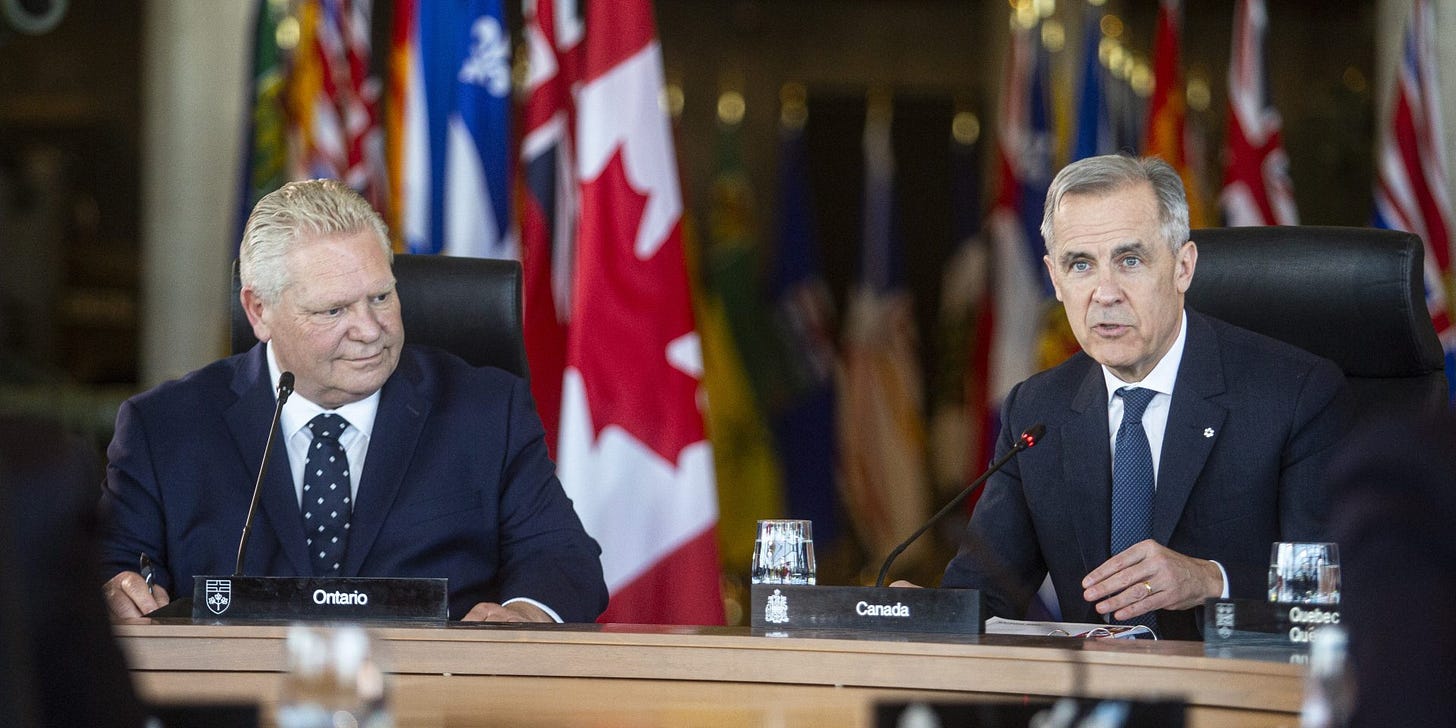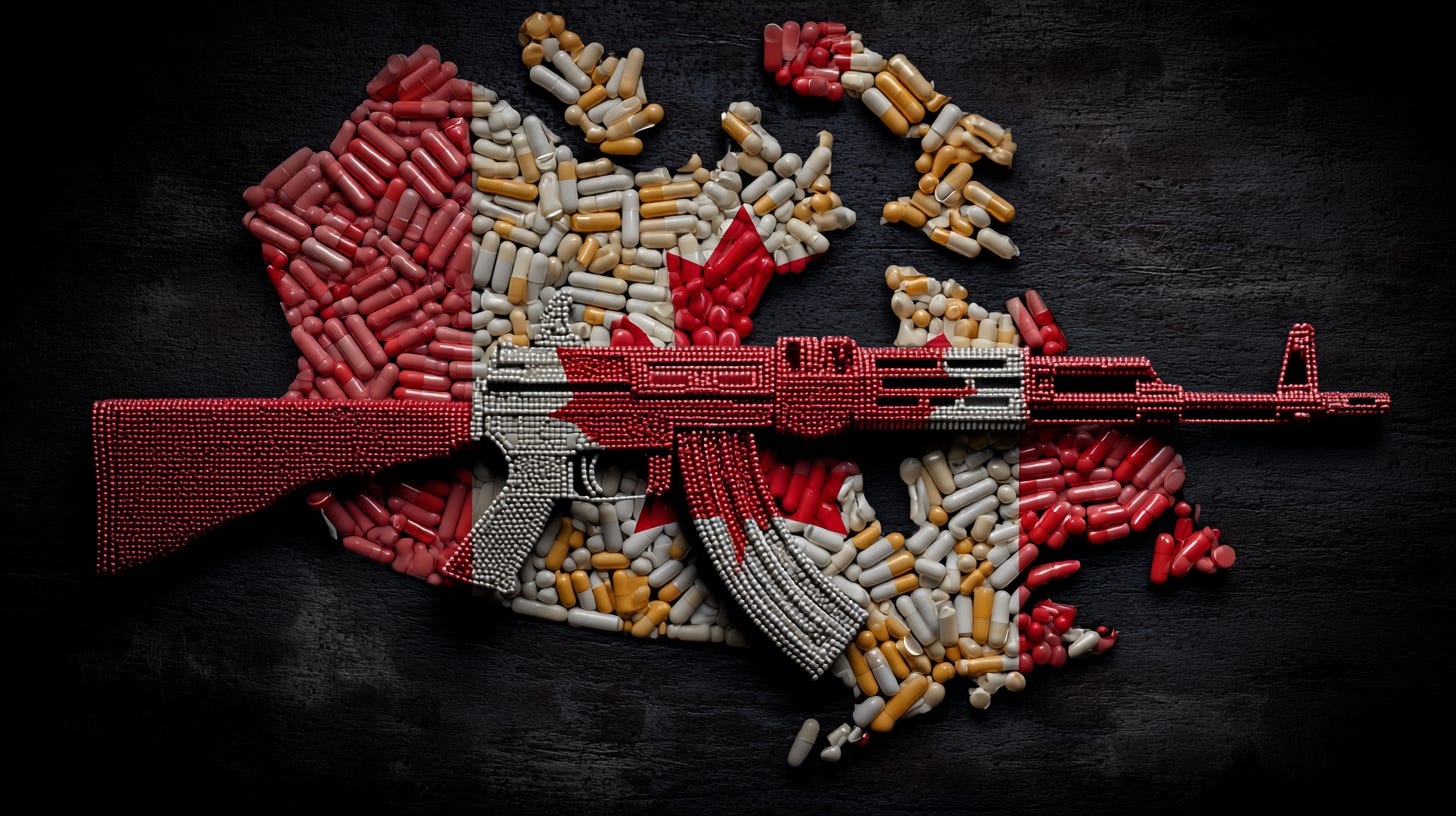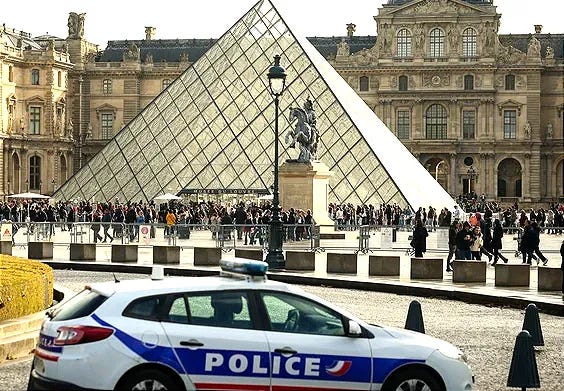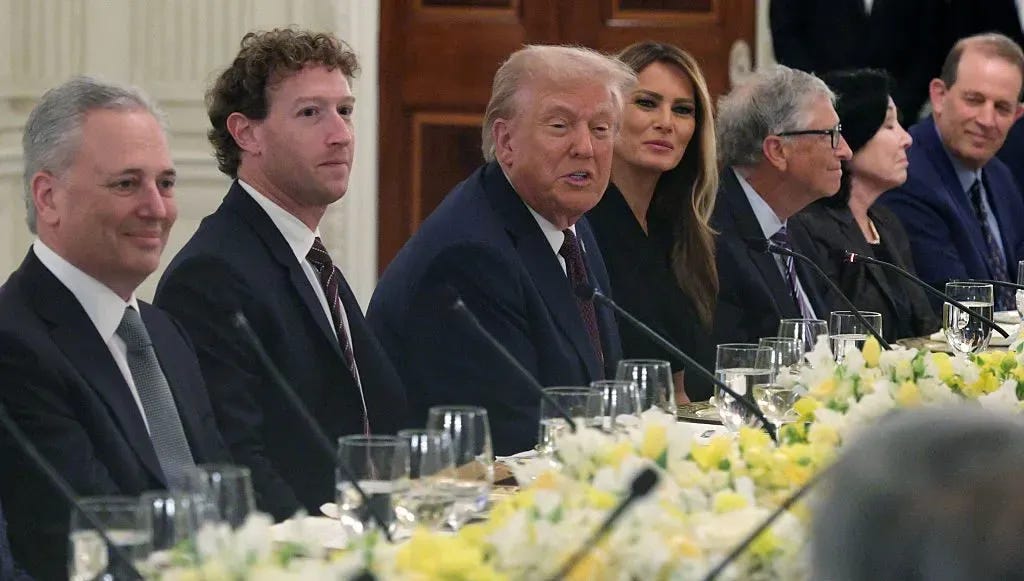Good morning, it’s Monday, October 27th. In today’s news, Canada’s federal and provincial leaders strain U.S. trade ties, Donald Trump is vindicated on Canada’s role in the fentanyl crisis, thousands rally for Alberta independence in Edmonton, Israel backs four militias to replace Hamas, and much more.
First time reading the daily blend? Sign up here.
Top-Down Blunder: Federal and Provincial Governments Torch US Trade Relations
In an escalating trade spat with the United States, Canadian provinces have blundered into foreign policy territory, launching costly, ill-advised ad campaigns against US tariffs that have now provoked retaliation from President Donald Trump and triggered backlash from Ottawa. It’s a textbook case of provincial overreach undermining national diplomacy, risking billions in trade, and exposing just how chaotic Canada’s foreign messaging has become.
It started with Ontario Premier Doug Ford’s $75 million anti-tariff campaign—a TV ad blitz across major US networks featuring Ronald Reagan’s 1987 remarks on protectionism. Airing during marquee events like the World Series, the ad aimed to sway American public opinion against tariffs on Canadian goods.
Trump quickly fired back, calling the ad “FAKE” and a “serious misrepresentation of the facts,” accusing Ford of twisting Reagan’s words. Within days, the President slapped a new 10% tariff on all Canadian imports, effective immediately—punishment for Ford’s refusal to pull the ads right away. He only paused them after the weekend’s broadcasts. This followed Trump’s decision on October 23, 2025, to terminate ongoing trade discussions with Canada altogether.
Instead of learning from Ontario’s fiasco, BC Premier David Eby decided to double down, launching his own digital ad campaign to protest US forestry tariffs. He claimed Americans “need to hear how tariffs raise prices,” arguing that the US charges higher duties on Canadian lumber than on Russian imports—a “tax on middle-class Americans.” BC Forests Minister Ravi Parmar joined in, painting the campaign as resistance to US “bullying” and a defence of Canadian forestry workers.
But the results speak for themselves. These provincial ad wars have only worsened the situation. Sectors like steel, aluminum, autos, and lumber—already under pressure—now face even steeper challenges. Ford’s stunt, in particular, showed how one province’s rogue decision can provoke immediate, painful consequences for the entire country.
Even Alberta Premier Danielle Smith, while commending Ford for finally hitting pause, urged a return to federally led negotiations, signalling quiet frustration with the provinces’ scattershot approach.
Ottawa’s response has been blunt. Prime Minister Mark Carney, speaking from the ASEAN summit in Malaysia, reminded premiers that trade negotiations are “the sole responsibility of the Government of Canada.” Cabinet Minister Dominic LeBlanc reinforced that message, while former Trudeau aide Brian Clow urged Carney to use the summit to de-escalate before the new tariffs take full effect.
The contrast is clear: while the federal government struggles to project unity, provincial leaders are freelancing international policy on taxpayer dollars—and Canada’s credibility is burning for it.
If premiers truly want to defend their provinces’ economic interests, they should stop trying to play diplomat on cable TV and let Ottawa do its job. That being said, Ottawa has to do its job. To date, Mark Carney’s government has been slow, weak, and reactive on trade, leaving a leadership vacuum that provinces are now trying—and failing—to fill.
The truth is, both levels of government have botched this. Carney lit the fire, Ford and Eby poured gasoline on it, and now Canadians are left sifting through the ashes. Until Ottawa shows real results at the negotiating table and the provinces learn to stay in their lane, Canada’s trade reputation will keep burning.
Donald Trump Was Right About Canada’s Role in the Drug Crisis
Donald Trump was right when he said Canada is playing a dangerous role in the North American drug crisis. For years, Canadian officials have downplayed the country’s place in the global drug trade—pretending our problems begin and end with a few unlucky addicts, rather than with the industrial-scale production and laundering operations happening right under our noses. However, Canada is not just a victim in this story. It’s a key hub.
This week, RCMP officers uncovered a massive “super lab” just forty-five minutes north of Toronto—a synthetic-drug facility capable of producing millions of dollars’ worth of fentanyl, methamphetamine, MDMA, and GHB. The operation, hidden in Schomberg, Ontario, was industrial in every sense. Officers seized nearly $10 million in narcotics and chemical precursors, a pill press, firearms, drug “recipes,” and 20,000 litres of toxic waste. The bust involved a ten-day hazardous materials cleanup and the cooperation of multiple agencies.
The suspects—Christopher O’Quinn, Liang Xiong Guo, and Katie King—face thirty-three charges in total, including production, trafficking, and weapons offences. O’Quinn alone faces twenty counts tied to the manufacture of Schedule I drugs and possession of precursor chemicals. On paper, this looks like a major victory for law enforcement—a triumph against organized crime. But Canadians have seen this story before.
Just last year, another massive “super lab” was uncovered in the small town of Falkland, British Columbia — a facility described as the largest and most sophisticated synthetic-drug operation in Canadian history. Officers seized 390 kilograms of methamphetamine, 54 kilograms of fentanyl, 35 kilograms of cocaine, and nearly 90 firearms. It was an industrial-scale drug empire hidden in a town of fewer than a thousand people — a site capable of manufacturing enough fentanyl to kill millions.
Yet despite the staggering scale of the operation, only one suspect, Gaganpreet Randhawa, has been publicly charged. No other arrests have been announced, and the case has largely faded from public attention.
These busts are flashy. They make for strong press conferences. But they fail to address the real problem: the entrenched criminal networks that have captured Canada’s ports, housing markets, and even financial institutions. Money laundering, by the government’s own estimates, now rivals some of Canada’s top 10 largest industries, with $45 billion to $113 billion in illicit funds flowing through real estate and shell companies each year—while politicians look the other way.
Until our leaders confront the system itself—the ports, the banks, the bureaucrats who enable it—these busts are theatre. If Canada refuses to root out the corruption at the top, then we must face the truth: this is no longer a nation governed by laws. It is a nation run by criminals—for criminals.
Thousands Rally for Alberta Sovereignty in Edmonton
The Alberta legislature turned into a sea of blue this weekend as thousands of Albertans gathered for the “I Am Alberta” rally — the largest pro-sovereignty demonstration in the province’s history. Estimates varied between 5,000 and 10,000 attendees, with drone footage still being reviewed. This signals that Alberta’s independence movement is no longer a fringe idea.
Organized by the Alberta Prosperity Project (APP), the rally featured speeches from key figures like constitutional lawyers Jeffrey Rath and Keith Wilson, Whistle Stop Café owner Chris Scott, and APP CEO Mitch Sylvestre. Their message was clear — Ottawa’s grip on Alberta’s future must end.
Rath, the APP’s general counsel, told the crowd that Premier Danielle Smith’s attempts to work with the federal government had failed. “It’s time to get on board the freedom train,” he said, declaring October 25 as “Alberta Independence Day.” Rath also claimed that over 300,000 Albertans have pledged to sign the group’s referendum petition, far outpacing former deputy premier Thomas Lukaszuk’s pro-Canada counter-petition.
Keith Wilson warned that things are only “destined to get worse” under a federal government pursuing censorship legislation like Bill C-9. He vowed that a province-wide referendum on independence would take place by 2026, urging attendees to discuss the benefits of sovereignty with friends and neighbours. “The uncertainty of independence,” he said, “is less frightening than the certainty of a dystopian federal government in Ottawa.”
Rath went further, accusing Prime Minister Mark Carney’s government of turning Canada into one of the most corrupt nations in the world, citing the influence of the World Economic Forum over federal policy. He also claimed that Donald Trump’s administration had expressed “ample support for Alberta becoming an independent country.”
While critics have dismissed the movement as unrealistic, Saturday’s rally demonstrated growing public frustration with federal overreach — from energy policy to free speech restrictions. For many Albertans, the message is no longer about negotiation but separation.
As one speaker put it, “We just want to get Ottawa’s knee off our neck.”
Whether or not Alberta ever leaves Confederation, one thing is now certain: the sovereignty movement is gathering real momentum, and Ottawa can no longer afford to ignore it. Source.
The Plan for ‘New’ Gaza—and the Four Militias Israel Is Backing to Replace Hamas
Four armed militias in Gaza—led by Hossam al Astal, Yasser Abu Shabab, Rami Halas, and Ashraf al Mansi—are receiving Israeli support as part of a coordinated project called “The New Gaza.” Operating within areas under Israeli control, these groups aim to remove Hamas from power while providing civilian support, including food, medical care, and basic services.
The militias receive supplies, vehicles, and ammunition via Israeli-controlled border crossings, and although they deny direct coordination with the IDF, Israeli airstrikes have occasionally assisted them in clashes with Hamas. Some groups also appear to have backing from outside powers, including the UAE.
Militia leaders describe their initiative as a bid to establish a new governance structure in Gaza, free of Hamas influence, with security and services for residents in areas under their control. However, by providing weapons, supplies, and indirect support to these militias, Israel’s role raises questions under the ceasefire, as such proxy tactics risk escalating conflict and could be seen as violating the agreement’s terms. More
Four Suspects in Louvre Heist in Custody Following Week-Long Manhunt
French authorities have arrested four men in connection with a daring daytime heist at the Louvre museum in Paris, where thieves stole eight pieces of jewelry valued at approximately $102 million. The suspects, reportedly experienced criminals from Seine-Saint-Denis, were tracked via DNA and fingerprint evidence.
The robbery, which took just seven minutes, targeted royal and imperial jewelry, including tiaras, necklaces, and earrings, though a crown with over 1,000 diamonds was dropped during the escape. French officials acknowledged serious security lapses and are still investigating whether the stolen items have been moved abroad. Authorities warn the case likely involves organized crime but remain hopeful about recovering the loot. More
President Javier Milei’s Party Wins Big in Argentina’s Midterms - Milei gained ground as voters backed his free-market reforms and deep austerity measures, providing a strong boost for the libertarian leader to continue his economic overhaul. More
China and US Reach Tentative Trade Deal and Avoid 100% Tariffs - More
Putin Says Tests Complete on New Nuclear-Capable Cruise Missile with ‘Unlimited Range’ - More
Food Stamps Are Set to Expire for 41 Million People as US Shutdown Continues - More
2028 US Democratic Presidential Contenders:
Newsom Confirms He’s Considering 2028 Presidential Bid - More
‘I Am Not Done’: Kamala Harris Considers 2028 Presidential Run - More
The Real Danger of the AI Bubble
As artificial intelligence continues to advance at an unprecedented pace, investors are rushing to pour capital into AI-driven companies, driving valuations to historic highs. While some commentators warn of a broad financial collapse, the real risk is far more targeted—and tied to the technology itself rather than the entire financial system.
AI is poised to deliver massive productivity gains, especially for industrial firms that adopt it effectively, but these gains come with inevitable creative destruction. Entire companies could collapse if they fail to keep pace with innovation or if new, superior algorithms render existing technology obsolete. Workers across sectors may be displaced as processes become automated and new efficiencies are realized.
The true danger of the AI bubble isn’t a system-wide crash—it’s which firms survive and which fail in the coming wave of innovation and how well economies can adapt to rapid technological disruption. Investors, policymakers, and business leaders will need to navigate this era carefully, distinguishing sustainable growth from hype-fuelled valuations. More
Bank of Canada Expected to Cut Rates Again as Trade Turbulence Persists - More
68 Pizza Hut Locations Closing Amid Collapse - Pizza Hut, founded in 1958, used to be the biggest global pizza chain, but it lost its sales crown to Domino’s in 2017. More
Novartis to Acquire Avidity Biosciences for About $12 Billion - The acquisition is intended to help Novartis gain a stronger foothold in the US market. More
Scientists Launch $14.2 Million Project to Map the Body’s “Hidden Sixth Sense”
A team from Scripps Research and the Allen Institute, led by Nobel laureate Ardem Patapoutian, has received $14.2 million from the NIH to create the first comprehensive atlas of interoception—the brain’s internal sensing system that monitors functions like breathing, blood pressure, and immune activity.
The project will map neural circuits connecting the brain to organs such as the heart, lungs, and gut, using 3D imaging and genetic profiling to identify different cell types. By decoding this “hidden sixth sense,” researchers hope to uncover how brain-body communication maintains health and how disruptions may contribute to conditions like chronic pain, autoimmune disorders, high blood pressure, and other diseases. More
Researchers Build Working Memory Devices from Mushrooms - Ohio State researchers created biodegradable computer memory using shiitake mushrooms, achieving 5,850 signals per second with 90% accuracy, offering an alternative to traditional semiconductors without rare-earth minerals. More
World Series: Bichette Back in the Lineup as Scherzer Faces Glasnow in Game 3 Tonight
As the World Series shifts to Los Angeles tied at one game apiece, the Toronto Blue Jays take on the Dodgers in a high-stakes Game 3 tonight. Shortstop Bo Bichette is set to return to the lineup at second base after missing most of Game 2, strengthening Toronto’s offence and providing crucial firepower against a formidable Dodgers pitching staff.
On the mound, veteran Max Scherzer will start Game 3 for Toronto, facing off against LA’s Tyler Glasnow. Shane Bieber and Shohei Ohtani are slated to start Game 4, setting the stage for another thrilling pitching duel.. More
Former Jets Center Nick Mangold Dies at 41 Due to Complications From Kidney Disease - More
Giants Rookie RB Cam Skattebo to Have Surgery After Gruesome Season-Ending Ankle Dislocation - More
Turkish Man to Pay “Cat Support” of 10,000 Liras Every Three Months for Up to 10 Years Following Divorce
Man Gets Caught on Camera Torching His Porsche and Fabricating a Kidnapping Claim in Attempt to Collect Insurance
On This Day in 1881, the Gunfight at the O.K. Corral—the Wild West’s most infamous shootout—erupts between lawmen, including Wyatt Earp, and the Cowboys, leaving Tom and Frank McLaury and Billy Clanton dead.



















Good Morning! After reading Blendr's post on the bust of another superlab, this time in Toronto, was curious on how many have been discovered in Canada. (Side note: I've been using Brave AI to research and can confidently say that it has a built-in bias, it's been interesting debating AI and having it admit I am correct lol). Anyway, from 2018 to 2024 (a cumulative 7 yrs) there was 44 fentanyl labs busted in Canada, but from Jan. 2024 to date there have been 50 fentanyl lab busts. Trump was inaugurated Jan. 21,2025 so it would appear that Canada was indeed not taking the drug crisis seriously until Trump accused Canada of being a hub for fentanyl trafficking. Sad isn't it?